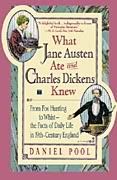— Love @ 13:39 Comments (4)
Filed under: B, English, History, Literature
 What Jane Austen Ate and Charles Dickens Knew
What Jane Austen Ate and Charles Dickens Knew
by Daniel Pool

English
416 pages
Touchstone
ISBN: 978-0-671-88236-5
First line: What were the assizes?
Back cover blurb:
For every frustrated reader of the great nineteenth-century English novels of Austen, Trollope, Dickens, or the Brontës, who has ever wondered whether a duke outranked an earl, when to yell “Tally-ho!” at a fox hunt, or how one landed in debtor’s prison, here is a “delightful reader’s companion that lights up the literary dark.” (The New York Times)
This fascinating, lively guide clarifies the sometimes bizarre maze of rules, regulations, and customs that governed everyday life in Victorian England. Author Daniel Pool provides countless intriguing details (did you know that the “plums” in Christmas plum pudding were actually raisins?) on the Church of England, sex, Parliament, dinner parties, country house visiting, and a host of other aspects of nineteenth-century English life—both “upstairs” and “downstairs.”
An illuminating glossary reveals the meaning and significance of terms ranging from “ague” to “wainscoting,” the specifics of the currency system, and countless other curiosities of the day.
Thoughts: I’ve read a lot of 19th century British fiction in my day (though there’s a lot more out there that I haven’t), and some things I’ve picked up on from context, but some (most?) I still had a woeful lack of understanding for. This book cleared up some of those, by virtue of being full of useful facts.
What’s more, though, is that it is also full of little interesting anecdotes related to these facts. My favourite, which made me giggle out loud, follows below.
The neutral ground of a great estate, after all, was one of the few mattress-filled places a woman could go in the days before “ladies” could visit restaurants and hotels. Assignations, therefore, were apparently not unknown, although negotiating one’s way around a large mansion at night in order to carry them out was sometimes eventful. Lord Charles Beresford in the 1880s flung himself gleefully into a darkened room one night and jumped into bed, with a shout of “Cock-a-doodle-do”—only to find, when the lamps were lit, that the bishop of Chester was on one side of him and the bishop’s wife on the other.
Also, as the back cover promises, it gives one (if one is at all interested) the definition of the word “wainscoting”, which has had, for the past five or so years, an uncanny ability to randomly pop up inside my head and refuse to leave me alone, so I’m stuck having to silently repeat the word time and time again inside my own head. (I might have inadvertently proclaimed myself to be mental right there, but I’m not much bothered.) For those of you who don’t know:
Wainscoting: Wainscot was a kind of fancy oak imported from Russia, Holland or Germany. The term “wainscoting” was applied to panels that were originally made out of such oak.
All in all, a very interesting book which, apart from earning a B rating, has made me really want to re-read Tess of the d’Urbervilles by Thomas Hardy, preferably two seconds ago. Alas, I don’t think I have the time for it at the moment, so I’m saving it for later on this month when I have a lot of time off from work (and also plan on reading Crime and Punishment).

9 Mar 2008 at 22:01
Now I want to read this too! On to the wishlist it goes…
10 Mar 2008 at 21:16
I have no doubt it will come in quite handy for future readings of 19th century fiction.
10 Mar 2008 at 21:23
I’ve had this book on my Amazon.com wishlist for so long and now I’m definitely going to buy it :)
2 Apr 2008 at 13:20
[…] What Jane Austen Ate and Charles Dickens Knew; Daniel Pool, B […]